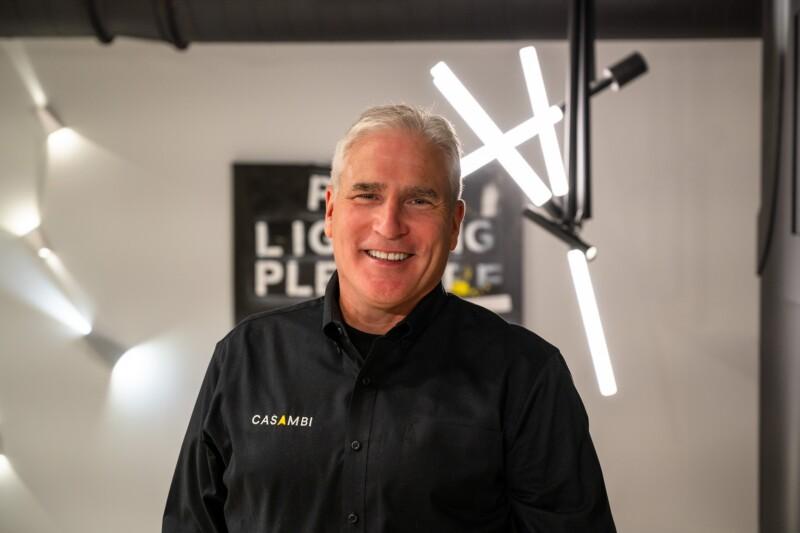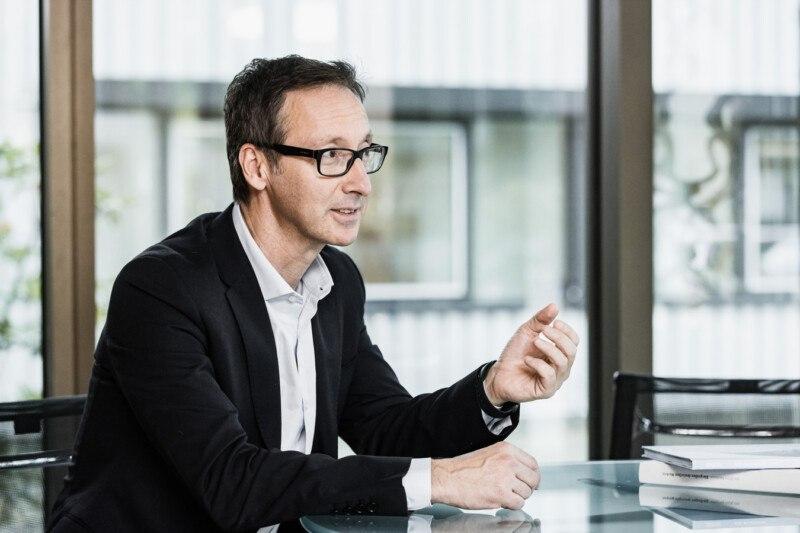Getting to know a Casambi sensor manufacturer – Danlers
 Martin Hosey, Product Manager (L) and Kevin Johnstone, Chief Operating Officer (R) at Danlers.
Martin Hosey, Product Manager (L) and Kevin Johnstone, Chief Operating Officer (R) at Danlers.
Danlers was one of the first to put Bluetooth into a PIR – much to the cynicism of their industry peers. Ignoring the naysayers paid off, proving that the company is inherently open to innovation they see will give them an edge.
Because of the critical mass achieved today, Casambi is widely considered the de facto standard for Bluetooth wireless lighting controls. But it wasn’t always this way. Back in the 2010s, we were out there selling a vision that few people could fathom. We had to find those initial partners who saw the same big picture – for whom ‘why’ wasn’t the insurmountable hurdle and ‘how’ was a delightful challenge. Today, some of our greatest partners are the ones we found back then – we’ve grown together and many of the biggest bets we made are playing out.
Danlers is a family-owned UK company with a rich heritage of designing and manufacturing innovative, high-quality, energy-saving, electronic controls from their offices and factory in Chippenham, England. They were early adopters of Casambi and now have 20+ Casambi Ready sensors on the market. We caught up with Kevin Johnstone, Chief Operating Officer, and Martin Hosey, Product Manager at Danlers for a chat about their secret sauce to success. Here’s an extract;
Danlers was one of the first to put Bluetooth into a PIR (Passive Infrared Sensor) at a time when the industry hadn’t yet woken up to the potential of the wireless communication technology. They found in Casambi, explains Kevin, a partner with a shared vision of the future. Both parties wanted to advance the industry, reduce the environmental footprint of lighting, create flexibility, and put smarter control into the hands of the end user.
‘My logic was that everybody knows Bluetooth. It’s in their car, on their phone. It’s a technology familiar to everyone. But we quickly realized that we needed a very good partner in software and firmware development. Casambi had a good model, you’re out the front by a reasonable way and other players are now following suit. Today, lighting control is no longer a black art. It’s become more user-friendly such that anyone can use light controls. That’s where the main benefits come from.’
‘The long-held way of working involved someone charging you £800 a day to go in and commission a building when all you actually wanted was to change a particular light fitting. At Danler’s, we advocate for ownership. Once a lighting installation is configured, the owner should be able to take full control. With Casambi, this becomes possible. And by offering remote commissioning, it not only becomes financially better but environmentally too with less travel and the opportunity to upgrade devices over the air [keeping installed devices active for longer]’ states Kevin.
However, he goes on to explain, successfully shifting the paradigm requires patience and timing. There’s another conundrum in the industry right now. When integrating a sensor into a luminaire, the manufacturer must charge more for the unit. This stumps the specifier who needs to comprehend that the lights are now doing more than switching on and off, they are doing other things in the background. Articulating that added value – the total cost of ownership – against the upfront spend is challenging and takes time.
‘From our point of view’, states Kevin, ‘we’ve done the groundwork and research in anticipation of where the market’s eventually going to go – so should a customer want something particular; they’re not going to wait a year to get the product … they could be waiting a matter of weeks and we’ve got something ready for them.’
Danlers has seen that the unfolding energy crisis is shining a brighter light on sensor capabilities. In a bid to balance the investment and running costs against the energy-saving capabilities of sensors, they’ve found that the market has become increasingly interested in a product’s minutiae – to the point that quiescent currents (referring to the amount of current a circuit consumes when it is in a no-load, non-switching, but enabled condition) are studied.
‘The last couple of years have been very challenging, in a positive way. And as a result, we’ve entered into more collaborative design projects – putting our skills to use to co-create the needed solutions today.’
As such, flexibility is at the core of Danlers’ business and design philosophies. Martin explains that they are very keen and able to develop solutions for ecosystems should the opportunity arise;
‘We don’t tend to stay fixed on a certain strategy. We prefer to be led. Our expertise lies in the design and manufacturing of products, particularly sensors. In this respect, customer-centricity drives innovation. As opposed to forcing our ideas onto the market, we encourage design partnerships. Firstly, by making an effort to truly understand customers’ wants and requirements and then designing a solution for them. It’s about influencing change in a proactive and inclusive way, rather than forcing it.’
Danlers’ roadmap contains many lanes. Martin explains that they’re looking at emerging sensor technologies and focused on getting more environmental sensors into the various ecosystems. They’re exploring different methods of presence detection and working on different options for people counting.
‘We’ve found that PIR is finally widely accepted. But now, I think people’s expectations for sensors are increasing. The granularity must be finer. Sensors must offer more, but still, be cost-effective’.
Today, it’s important to understand how buildings are evolving and how the use of the building is changing. Buildings and their operational systems need to be more flexible and the cost of managing that change is becoming more of a challenge. It’s important to understand the drivers of change explains Kevin,
‘OK, we’re dealing with energy at the moment. But prior to the energy crisis, it was about the environment. Prior to the environment, it was LED. Prior to the LED, it was about energy saving. We’ve almost gone full circle. Covid has changed people’s perception of work. How they work. When they work. What they do at work. All this change is flowing into the building itself. Designers are now looking at how buildings can be configured to be the most flexible, better controlled and easily reconfigurable.’
As such, Danlers takes an agnostic, big-picture approach to sensors. Martin adds;
‘Lighting is a great conduit for obtaining data. It’s in every building. To bring smart buildings to life, we need to get from lighting into other sensor technologies such as CO2, temperature, humidity – environmental sensing. When this all comes together, you can truly improve the human health and well-being standards of a building in one fell swoop. CO2 sensors, particularly true CO2 sensing, are fast becoming a requirement for new builds – they’re recognized as particularly useful for schools for example.’
According to Kevin and Martin, Casambi has been very fast and easy to incorporate. Danlers knows and engineers the sensors. Casambi talks to the luminaire without having to be physically connected. This match, they say, plays on each other’s strengths and encourages the development and introduction of the right products to market at the right time.
‘What we did was to first make sure that Casambi fit the same shapes. The market and the Casambi Ecosystem dictate the needs in terms of new solutions. Danlers can then quickly answer the call to action. It’s so easy, it’s like falling off a log. If you don’t respond to market demand quickly, there’s a risk that the market will simply revert back to the old ways, and nothing evolves’ adds Kevin.
However, education and ecosystem support are key to success. Danlers takes a wholesale/distribution route to market and the successful execution of such a strategy relies on trustworthy relationships. Danlers has supplied sensors to some huge, high-profile projects (The BBC and Ulster Hospital to name a couple) which are looked after by what they call ‘preferred’ suppliers.
‘The priority for me is ensuring that the supplier is fully clued up on the capabilities of our technology – considering that wireless control is still a fairly young concept. So that when they are selling our products into projects, they really understand how the sensor works, and what the limitations are. Danlers has got an approach of honesty. And that’s what our reputation within the Casambi Ecosystem is built on.’ States Kevin.
Supplying the sensors for Ulster Hospital’s new Acute Services Block (a newly constructed eight-story building with over 31,000m2 of floor space), Danlers worked closely with the commissioning partners, Chroma Lighting, to ensure that the sensors met all the requirements in functionality and interoperability between all elements.
Many people might say that the UK lighting design and lighting controls market is technically so much more advanced than Europe and the rest of the world. But according to Kevin this is a dangerous assumption to make.
‘To an extent, I agree… But personally, I think Europe seems to be more accepting of ecosystems compared with the UK. The UK is still predominantly about DALI and switching. And specifiers are fixed in their routines. But I think that’s changing as the younger tech-savvy generations enter managerial and decision-making positions.’
Capturing the attention of the up-and-coming is important to the company. Danlers is successfully experimenting with new ways of inspiring fresh thinking in the industry. Kevin shares more;
‘Half the problem is that new industry entrants usually undergo apprenticeships, and so they are being influenced by the older generation. In this way, older ideas and ways of working are being pulled through. So, I think you must influence the newcomers using new media. At Danlers, we started experimenting with TikTok videos. We’ve seen that it’s increased productivity and we’ve quickly secured 300+ followers, who are electricians. We start influencing them, and then indeed they can start influencing the specifiers’
Danlers’ advice for the up-and-coming lighting stars; Be bold. Change comes with you.
Interested in learning more about Casambi and joining our ecosystem? Drop us a note, and we’ll reach out to you:


